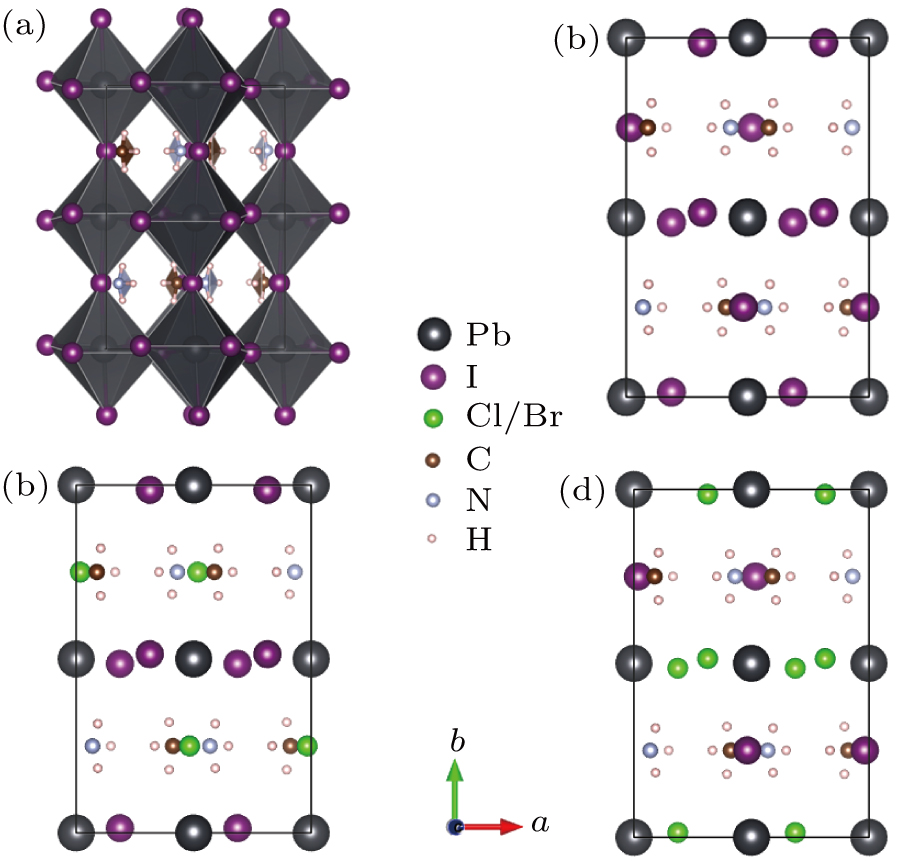Project supported by the Financial Support from the “12th Five-Year” Science and Technology Research Project of the Education Department of Jilin Province (Grant No. [2016] 494) and the National Natural Science Foundation of China (Grant No. 21173035).
Project supported by the Financial Support from the “12th Five-Year” Science and Technology Research Project of the Education Department of Jilin Province (Grant No. [2016] 494) and the National Natural Science Foundation of China (Grant No. 21173035).
† Corresponding author. E-mail:
Project supported by the Financial Support from the “12th Five-Year” Science and Technology Research Project of the Education Department of Jilin Province (Grant No. [2016] 494) and the National Natural Science Foundation of China (Grant No. 21173035).
Methylammmonium lead iodide perovskites (CH3NH3PbI3) have received wide attention due to their superior optoelectronic properties. We performed first-principles calculations to investigate the structural, electronic, and optical properties of mixed halide perovskites CH3NH3Pb(I1−yXy)3 (X = Cl, Br; y = 0, 0.33, 0.67). Our results reveal the reduction of the lattice constants and dielectric constants and enhancement of band gaps with increasing doping concentration of Cl−/Br− at I−. Electronic structure calculations indicate that the valance band maximum (VBM) is mainly governed by the halide p orbitals and Pb 6s orbitals, Pb 6p orbitals contribute the conduction band minimum (CBM) and doping does not change the direct semiconductor material. The organic cation [CH3NH3]+ does not take part in the formation of the band and only one electron donates to the considered materials. The increasing trends of the band gap with Cl content from y = 0 (0.793 eV) to y = 0.33 (0.953 eV) then to y = 0.67 (1.126 eV). The optical absorption of the considered structures in the visible spectrum range is decreased but after doping the stability of the material is improving.
Perovskites have a large family of compounds for the formula of ABX3 (A = rare-earth, alkali or alkaline earth metal, B = transition metal).[1–3] In the last few years, organic–inorganic hybrid perovskites ABX3 (A = organic methylamine or formamidinium cation; B = Pb2+ or Sn2+; X = I−, Br− or Cl−) formula as solar optical absorber materials were firstly reported by Miyasaka et al.[4,5] Methylammmonium lead iodide perovskite (CH3NH3PbI3), each Pb atom coordinates with six I atoms to form the PbI6 group.[6] Up to date, the three-dimensional (3D) perovskites structures consist of PbI6 octahedra play an important role as the superior optical absorbing materials.[7] With the increasing of temperature, the structure of CH3NH3PbI3 has a transition from Pnma phases (orthorhombic, below 160 K) to I4/mcm (tetragonal) and Pm3-m (cubic) phases at 330 K and higher temperature, respectively. The main difference among three phases is the ordering of the noncentrosymmetric [CH3NH3]+ cation.[8–13] The efficient solar cell absorbs a wide range spectra from 320 nm to 1000 nm, which are from the visible to near-infrared wavelengths range.[14] The hybrid organic–inorganic perovskites have the power conversion efficiency (PCE) from 3.8% in 2009 to 22.1% in 2016, which are considered as promising materials in the optical field.[15–24] The rapid development progress of CH3NH3PbI3 has never been found in other solar cells in history. Organic–inorganic perovskites based on the metal hybrids solar cells have attracted wide photovoltaic research due to its flexibility, easy manufacture, low-cost and high optical absorption efficiency to scientific and industrial applications.[25–36]
For the novel organic–inorganic perovskite materials, many efforts have been devoted to the replacement of A+, B2+, and X− by other ions to exploring their outstanding performance.[2,27] The hybrid organic–inorganic perovskites show excellent optical properties in recent experimental measurements and theoretical calculations.[9] The most common strategic choice to the candidates is the Goldschmidt concept, which were proposed by Cheetham and co-workers.[27,37] The ionic tolerance factor (τ) is to assess ionic radius size mismatches the following formed (Eq. (
 |
In the paper, we presented a systematic computational investigation to study the effect arising from chlorine/bromine doping on the structural, electronic and optical properties of the CH3NH3PbI3 perovskite based on density functional theory (DFT) calculations. The results indicate that the mixed perovskites have the larger band gap with the Cl−/Br− amount increases and has lower optical absorption efficiency compare with the archetypal halide perovskites.
The following ab initio structural optimization and electronic properties on CH3NH3Pb(I1−yXy)3 (X = Cl, Br; y = 0, 0.33, 0.67) perovskite structures were calculated by density functional theory (DFT) method with a plane-wave basis set, as implemented in Vienna Ab initio Simulation Package (VASP) code.[45,46] The generalized gradient approximation (GGA) parametrized by Perdew–Burke–Ernzerhof (PBE)[47] were adopted for the electron exchange–correlation energy functional. The electron–ion interactions were described by projected-augmented-wave (PAW)[48] pseudopotentials with 1s1, 2s22p2, 2s22p3, 6s26p2, 3s23p5, 4s24p5, and 5s25p5 and as valance electrons for H, C, N, Pb, Cl, Br, and I, respectively. All structures have been fully optimized by minimizing atomic forces and stress tensor components via the conjugate gradient algorithm. The Brillouin-zone (BZ) integration[49] has been performed on a Monkhorst–Pack 4 × 2 × 4 k-mesh grid and the plane-wave cutoff is set to 400 eV in all configurations. Calculations were performed with and without spin–orbit coupling. The total electronic energy tolerance is set to 0.1 e−4 and the force converge for the structural relaxation is 0.001 eV/Å. The crystal structures were explained by using the VESTA program.[50]
CH3NH3PbI3 has the orthorhombic structure in the Pnma space group as shown in Fig.
To address the effects of site different substitution concentrations, we consider two kinds of doping fractions of Cl−/Br− (y = 0.33 and 0.67) within I sublattice (Figs.
| Table S1. Calculated lattice parameters and selected inter-atomic distance (Å) for CH3NH3Pb(I1−yXy)3 (X = Cl, Br; y = 0, 0.33, 0.67) structures. . |
The perovskites with mixed halogen anions have different electronic and optical properties than Pb perovskites with pure halogen anions. To further investigate electronic properties of doping and pure CH3NH3PbI3, the band structure, total density of states (DOS), and partial density of states (PDOS) for the doping systems of CH3NH3Pb(I1−yXy)3 (X = Cl, Br; y = 0, 0.33, 0.67) are calculated. The calculated electronic band structures with and without spin–orbital coupling of the doping phases are shown in Fig.
From the PDOS of CH3NH3PbI3 (Fig.
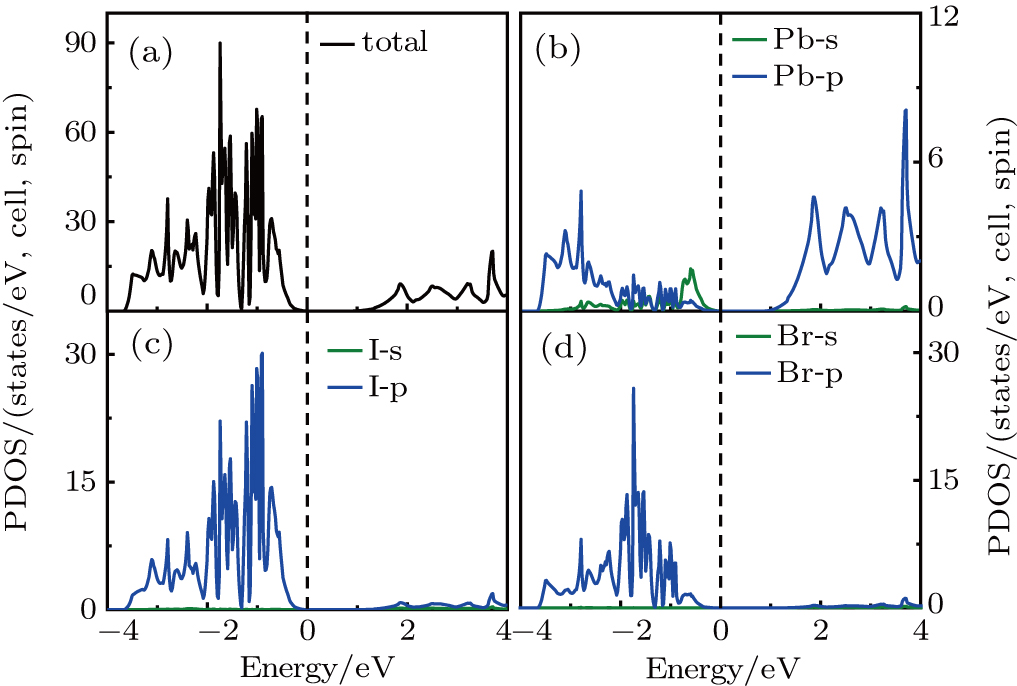 | Fig. 3. Calculated spin-dependent total and partial density of states (PDOS) of CH3NH3Pb(I1−yBry)3 for y = 0.33. The dashed line indicates the calculated Fermi energy. |
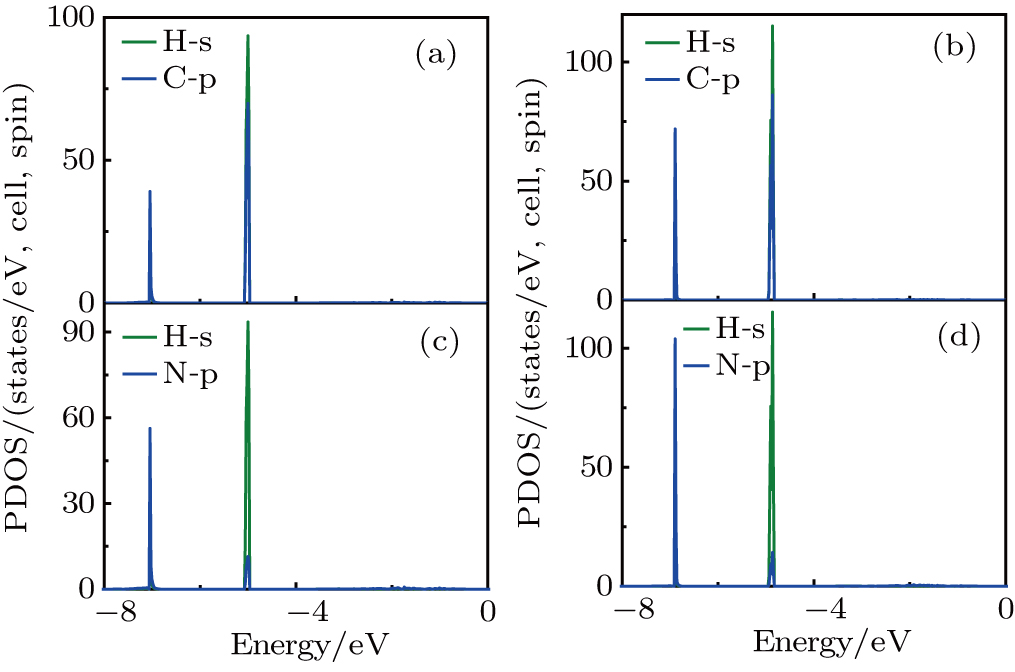 | Fig. 4. Calculated spin-dependent partial density of states (PDOS) of CH3NH3Pb(I1−yBry)3 for y = 0.33 (a) and y = 0.67 (b). |
The optical properties are important for organic–inorganic compounds, which can discover the potential applications in optoelectronic devices.[55] The linear optical properties can be obtained from the frequency-dependent complex dielectric function ε (ω) (Eq. (
 |
 |
 |
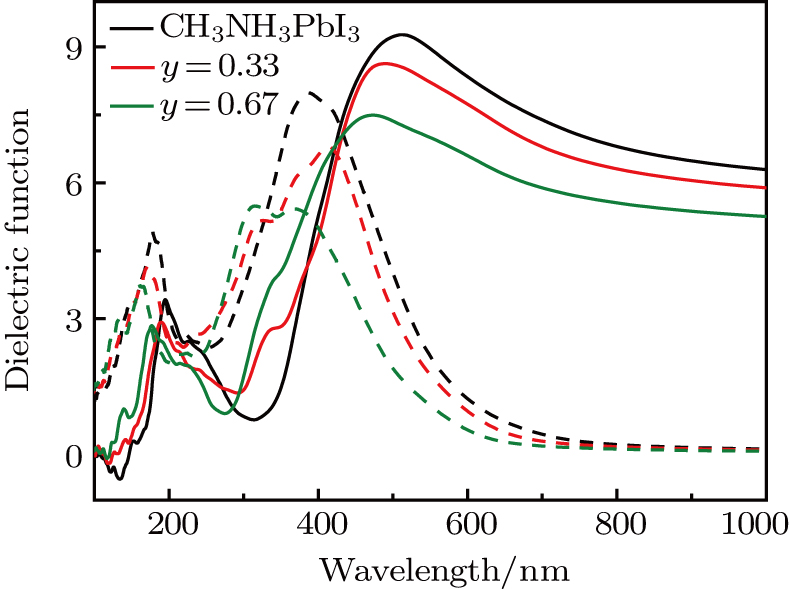 | Fig. 5. Real (solid line) and imaginary (dashed line) parts of the dielectric spectra of CH3NH3Pb(I1−yBry)3 (y = 0, 0.33 and 0.67). |
As we can clearly see that the doping compounds have a lower computed imaginary part than pure CH3NH3PbI3. The reason for this is that most semiconducting materials have larger band gaps and smaller dielectric constant (Table
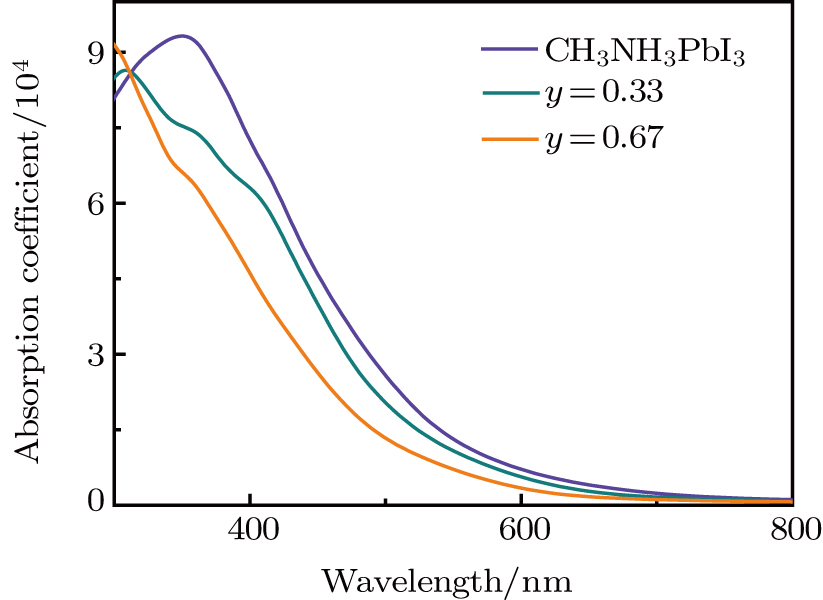 | Fig. 6. The absorption spectra of CH3NH3Pb(I1−yBry)3 (y = 0, 0.33 and 0.67) in the visible light spectrum. |
| Table 1. Calculated band gap (in unit eV) with and without spin–orbital coupling for CH3NH3Pb(I1−yXy)3 (X = Cl, Br; y = 0, 0.33, 0.67) α structures. . |
The Cl-doped structure with the band gap of 1.126 eV (y = 0.67) has a lower absorption coefficient than the Br-doped structure with the band gap of 0.989 eV (y = 0.67) (see Figs.
For the Cl-doped system, we consider the same doping concentration and occupation as the Br-doped system. It is interesting to find that when concentration is up to y = 0.33 and y = 0.67, we consider two kinds of site occupation, and obtain the same results for site different occupation position: α and β has the lower optical absorption, respectively (see Figs.
In the present paper, a systematic study of the mixed halide CH3NH3Pb(I1−yCly)3 and CH3NH3Pb(I1−yBry)3 perovskites with and without spin–orbit coupling for different y values is carried out by density functional theory calculations. We studied the anionic substitution, which leads to the change of the band gap, density of states, and optical properties of structures. From the calculated band structures and density of states, we can conclude that the considered structures are semiconductors with direct band gaps at the G point and with the increase of doping concentration, the band gap is increased. The band gap is dominated by spin–orbit coupling effects acting mainly on the conduction band. All the considered intensities of the absorption band are decreased, the hybrid perovskites show lower conversion efficiencies than the archetypal halide perovskites. In addition, the Cl-doped structures have smaller lattice distortions and dielectric function in the visible spectrum range in comparison with the Br-doped structures. From the above mentioned results of the high band gap and low absorption efficient, our investigations indicate that Cl/Br-doped perovskites are not good candidates for light materials in solar cells, but after doping the stability of the material improves. The results offer a theoretical foundation for experimental studies of the mixed perovskite and to further explore applications for the other types of materials.
| [1] | |
| [2] | |
| [3] | |
| [4] | |
| [5] | |
| [6] | |
| [7] | |
| [8] | |
| [9] | |
| [10] | |
| [11] | |
| [12] | |
| [13] | |
| [14] | |
| [15] | |
| [16] | |
| [17] | |
| [18] | |
| [19] | |
| [20] | |
| [21] | |
| [22] | |
| [23] | |
| [24] | |
| [25] | |
| [26] | |
| [27] | |
| [28] | |
| [29] | |
| [30] | |
| [31] | |
| [32] | |
| [33] | |
| [34] | |
| [35] | |
| [36] | |
| [37] | |
| [38] | |
| [39] | |
| [40] | |
| [41] | |
| [42] | |
| [43] | |
| [44] | |
| [45] | |
| [46] | |
| [47] | |
| [48] | |
| [49] | |
| [50] | |
| [51] | |
| [52] | |
| [53] | |
| [54] | |
| [55] | |
| [56] |


